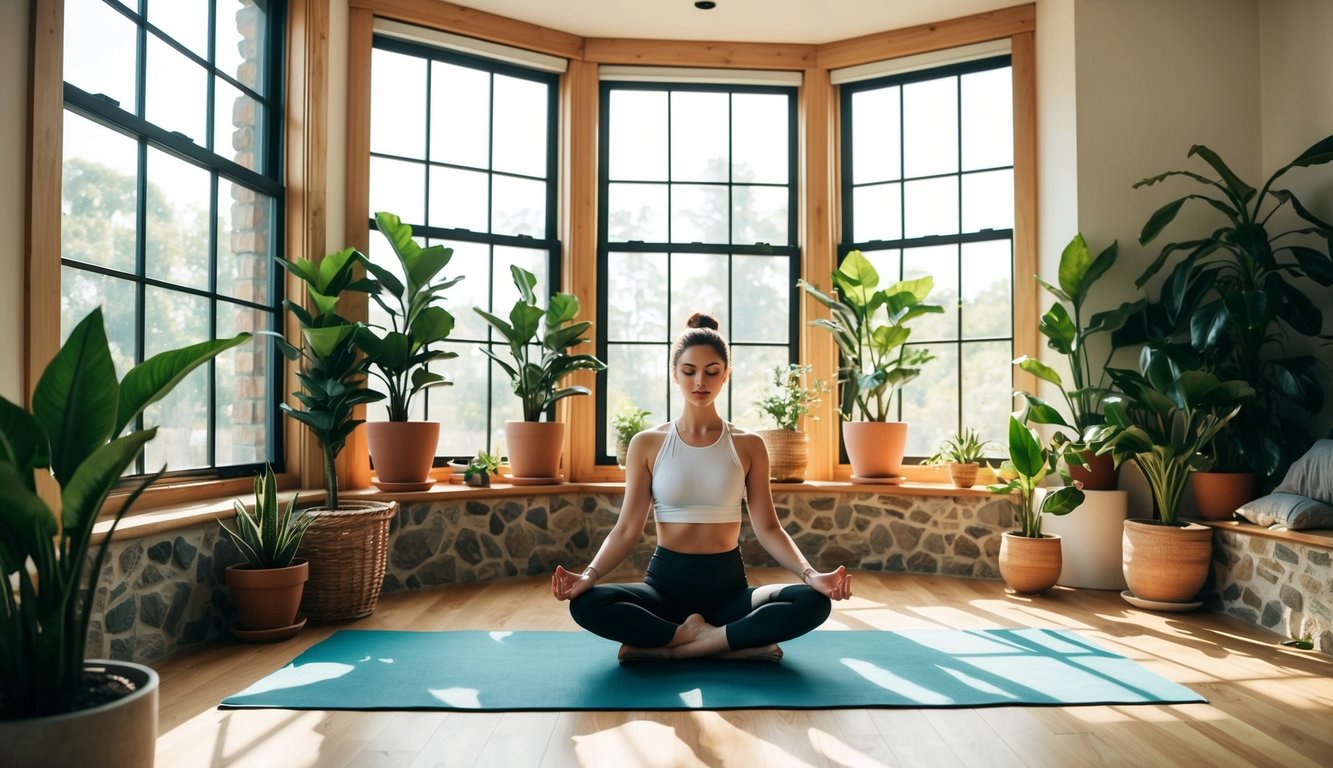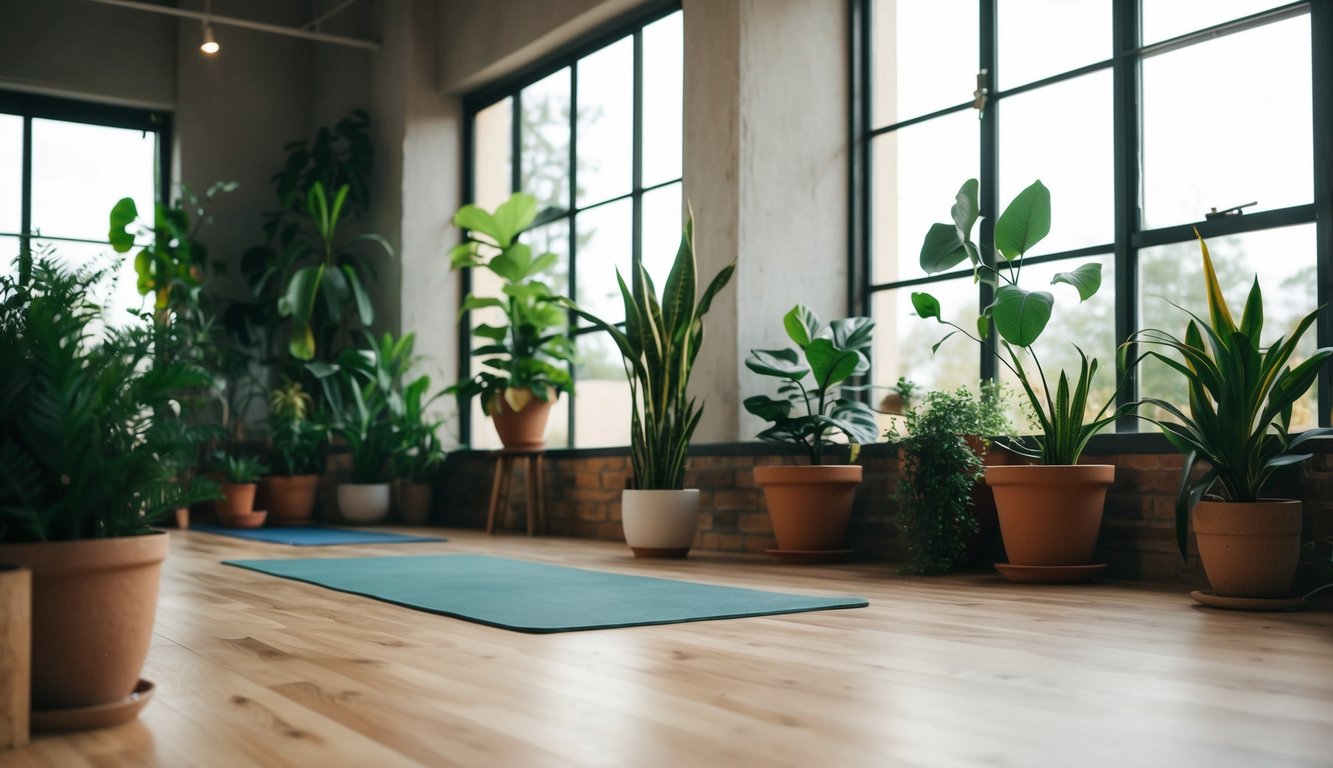Bringing nature indoors can transform your living or working space, creating a calming and rejuvenating environment. By incorporating plants and natural materials, you can enhance your daily practice, whether it’s work, meditation, or simply relaxing at home.
Integrating biophilic design principles into your space can improve air quality, reduce stress, and boost overall well-being.

Biophilic design focuses on connecting humans with nature in built environments. This approach goes beyond simply adding a few potted plants. It involves thoughtful selection of natural materials, maximizing natural light, and creating visual connections to the outdoors.
You can start small by adding a few indoor plants or incorporating natural textures like wood and stone into your decor.
Incorporating nature therapy into your daily routine can be as simple as taking short breaks to observe and interact with natural elements in your space. This practice can help reduce stress, improve focus, and promote a sense of calm and well-being throughout your day.
The Benefits of Incorporating Natural Elements
Bringing nature into your practice space offers profound advantages for both practitioners and clients. Natural elements create a calming atmosphere that promotes healing and well-being.
Physical and Mental Health Benefits
Indoor plants improve air quality by removing toxins and increasing oxygen levels. This leads to better respiratory health and increased cognitive function. Natural materials like wood and stone can regulate humidity, reducing airborne allergens.
Exposure to nature reduces stress hormones and lowers blood pressure. Even brief contact with plants can boost mood and decrease anxiety. Natural light from windows enhances vitamin D production and regulates sleep cycles.
Tactile experiences with natural textures stimulate the senses and promote mindfulness. The scents of essential oils or flowers can trigger relaxation responses. These elements combine to create a multi-sensory healing environment.
Enhancing Client Well-being and Practitioner Effectiveness
A nature-inspired space puts clients at ease, allowing them to open up more readily. Biophilic design elements like water features provide soothing background noise, masking outside distractions. This fosters a sense of privacy and safety.
Natural aesthetics create a positive first impression, building trust and credibility. Clients associate the calm environment with your expertise and care. This can lead to improved treatment outcomes and client retention.
For practitioners, a nature-infused workspace reduces burnout and fatigue. The restorative qualities of plants and natural light help maintain focus and empathy throughout the day. This environment supports your emotional well-being, allowing you to provide better care.
Connection to Nature and Biophilic Design Principles
Biophilic design taps into humans’ innate affinity for nature. Incorporating natural elements like wood, stone, and plants creates a subconscious connection to the outdoors. This satisfies our biological need for nature contact, even in indoor spaces.
Visual representations of nature, such as landscape artwork or nature photography, can evoke similar benefits to real plants. Fractal patterns found in nature, when used in decor, reduce stress and enhance cognitive performance.
Natural light and views of outdoor greenery strengthen the indoor-outdoor connection. If direct outdoor views aren’t possible, consider nature-inspired wallpaper or murals. These design choices create a sense of expansiveness and freedom within the practice space.
Selecting the Right Plants for Your Space

Choosing appropriate plants enhances the ambiance and functionality of your practice. Consider factors like maintenance needs, potential health benefits, and light conditions when making your selections.
Low-Maintenance Plants for Busy Practitioners
Choosing the right plants for your busy schedule is crucial. Snake plants and ZZ plants thrive with minimal care, making them ideal for practitioners with limited time.
Pothos and philodendrons are forgiving plants that can tolerate irregular watering. They also purify the air, creating a healthier environment for you and your clients.
Succulents and cacti are excellent choices for sunny spots. Their water-storing capabilities mean you can go longer between waterings without harming the plants.
Plants with Healing Properties
Incorporating plants with healing properties can enhance your practice’s therapeutic atmosphere. Aloe vera is well-known for its soothing gel and air-purifying qualities.
Lavender releases a calming scent, promoting relaxation and stress relief. It’s perfect for waiting areas or treatment rooms.
Eucalyptus is beneficial for respiratory health and can create a spa-like atmosphere. Its distinctive aroma can help clear the mind and boost focus.
Rosemary stimulates memory and concentration. Place it in areas where you need mental clarity and enhanced cognitive function.
Plants for Different Light Conditions
Assessing the lighting in your space is essential for selecting suitable plants. For low-light areas, consider cast iron plants or Chinese evergreens. These hardy species thrive in shaded corners.
Medium-light areas benefit from plants like peace lilies or rubber plants. They adapt well to varying light conditions and help purify the air.
For spaces with ample natural light, opt for fiddle leaf figs or bird of paradise plants. These statement pieces can create focal points in your practice.
Remember to rotate your plants regularly to ensure even growth and prevent leaning towards light sources.
Arranging Greenery for Maximum Impact

Strategic plant placement can transform your practice space, creating a soothing atmosphere that promotes well-being. Thoughtful arrangement maximizes the visual and functional benefits of greenery, even in compact areas.
Tips for Displaying Plants in Small Spaces
In limited spaces, think vertically. Use wall-mounted planters or floating shelves to display small potted plants without sacrificing floor space. Choose compact varieties like succulents or air plants that thrive in tight quarters.
Consider multi-tiered plant stands to showcase multiple plants in a small footprint. Place larger plants in corners to soften edges and create depth. Utilize windowsills for sun-loving plants, maximizing natural light.
Opt for plants with varying heights and textures to create visual interest. Group plants in odd numbers for a natural, balanced look. Use statement planters as focal points to draw attention and add personality to your space.
Creating a Focal Point with Plants
Select a standout plant with unique features like dramatic foliage or interesting structure. Position it in a prominent location, such as near the entrance or in a visible corner.
Use lighting to highlight your focal plant, creating depth and ambiance. Choose a decorative pot that complements your decor while enhancing the plant’s beauty.
Surround your focal plant with smaller, complementary plants to create a layered effect. This technique draws the eye and creates a natural, cohesive look.
Consider seasonal rotations to keep your focal point fresh and interesting throughout the year. This approach allows you to showcase different plants as they reach their peak beauty.
Using Vertical Gardens and Hanging Plants
Vertical gardens maximize space efficiency while creating stunning visual impact. Install a living wall system or use modular planters to cover bare walls with lush greenery.
Choose plants suited for vertical growth, such as ferns, philodendrons, or trailing succulents. Mix plant varieties for texture and color variety.
Hang plants from the ceiling or wall-mounted brackets to add dimension to your space. Macramé plant hangers offer a trendy, bohemian touch.
For a low-maintenance option, consider air plants displayed in glass terrariums or mounted on driftwood. These versatile plants require minimal care and add a unique element to your vertical display.
Incorporate biophilic design principles by combining your vertical garden with natural materials like wood or stone. This approach creates a harmonious, nature-inspired environment that enhances well-being and productivity in your practice space.
Integrating Natural Textures and Materials
Incorporating organic textures and materials into your practice creates a soothing, grounding atmosphere. Natural elements connect patients to the outdoors, promoting relaxation and healing.
Choosing Organic Materials for Furniture and Decor
Select furniture made from sustainably sourced wood like oak, maple, or bamboo. These materials add warmth and character to your space. Consider stone elements like marble countertops or slate flooring for a touch of elegance.
Opt for natural fabrics such as cotton, linen, or wool for upholstery and curtains. These breathable materials enhance comfort and air quality. Incorporate woven baskets, jute rugs, or sisal carpets to add texture underfoot.
Display artwork featuring natural scenes or made from organic materials. Driftwood sculptures, pressed flower art, or landscape photographs can serve as calming focal points.
Benefits of Natural Textures in a Healing Space
Natural textures stimulate the senses and promote a connection to the environment. Rough stone or bark textures can provide grounding sensations for patients. Smooth wood grain or polished river rocks offer a soothing tactile experience.
These elements can reduce stress and anxiety by creating a sense of biophilia – our innate affinity for nature. Exposure to natural materials has been shown to lower blood pressure and heart rate.
Organic textures also improve acoustics by absorbing sound. This creates a quieter, more peaceful atmosphere conducive to healing and relaxation.
Combining Different Textures for a Harmonious Look
Mix and match textures to create visual interest without overwhelming the senses. Pair smooth surfaces with rough ones, such as sleek wood furniture with textured throw pillows.
Layer different natural materials throughout the space. For example, use a wooden desk with a stone paperweight and a woven chair cushion. This creates depth and complexity in your design.
Use color to unify diverse textures. Stick to a neutral, earth-toned palette to maintain a cohesive look. Add pops of color with plants or nature-inspired artwork to enliven the space.
Balance is key. Avoid cluttering the space with too many textures. Instead, choose a few standout pieces to create focal points and areas of visual rest.
Creating a Biophilic Environment
Biophilic design connects people with nature in built environments. It improves well-being, productivity, and creativity by incorporating natural elements and patterns.
Understanding Biophilic Design
Biophilic design is rooted in our innate affinity for nature. It goes beyond adding plants to a space. This approach integrates natural elements, materials, and patterns into architecture and interior design.
Key principles include:
- Maximizing natural light
- Using natural materials like wood and stone
- Incorporating water features
- Mimicking natural shapes and forms
- Creating visual connections to nature
These elements work together to create spaces that feel alive and connected to the natural world. By tapping into our biological need for nature, biophilic design can reduce stress, enhance cognitive function, and improve overall well-being.
Practical Tips for Implementing Biophilic Principles
To create a biophilic environment in your practice, consider these strategies:
-
Maximize natural light:
- Use large windows, skylights, or light tubes to bring in sunlight.
-
- Add a variety of indoor plants, living walls, or even a small indoor garden.
-
Use natural materials:
- Choose furniture and finishes made from wood, stone, or bamboo.
-
Add water elements:
- Install a small fountain or water feature to create a calming atmosphere.
-
Mimic natural patterns:
- Use fabrics and artwork with organic shapes and earth tones.
-
Create views:
- Position seating to face windows or natural scenery when possible.
-
Improve air quality:
- Use plants and natural ventilation to purify the air.
Case Studies of Successful Biophilic Spaces
Several businesses have successfully implemented biophilic design principles:
Amazon Spheres:
- These glass domes in Seattle house over 40,000 plants from 30 countries. The space provides employees with a nature-rich work environment, boosting creativity and well-being.
Etsy Headquarters:
- The Brooklyn office features living walls, reclaimed wood, and abundant natural light. Employees report increased job satisfaction and productivity.
Khoo Teck Puat Hospital:
- This Singapore hospital incorporates extensive greenery, natural light, and water features. Patients experience faster recovery times and staff report lower stress levels.
These examples demonstrate how biophilic design can transform spaces, enhancing both physical and mental health for occupants.
Conclusion

Incorporating nature into your practice offers numerous benefits for both you and your clients. By bringing plants and natural materials indoors, you create a more calming and inviting environment.
Natural elements can reduce stress and improve focus in your workspace.
Consider adding a variety of indoor plants to enhance air quality and create a soothing atmosphere.
Integrating nature-based elements into traditional therapy settings can be as simple as using nature sounds or imagery during sessions.
You might also incorporate natural materials into art therapy activities.
For educators, bringing nature into the classroom can improve air quality and provide cognitive benefits for students.
Maximize natural light and use plants to create a more engaging learning environment.
Frequently Asked Questions

Integrating nature into educational settings enhances learning experiences and fosters holistic development. Natural elements provide rich opportunities for exploration, creativity, and language growth while promoting best teaching practices.
What are effective methods for integrating natural elements into classroom settings?
Bringing natural materials like wood, stones, and plants into the classroom creates a connection to the outdoors.
You can use these items as learning tools or decorative elements.
Create a nature corner with potted plants, terrariums, or a small indoor garden. This area can serve as a quiet space for reflection or a hands-on learning station.
Incorporate natural textures and colors in your classroom design.
Use earth tones, nature-inspired artwork, and organic shapes to evoke a sense of the outdoors.
How does the incorporation of nature impact student learning and development?
Exposure to natural elements improves air quality and regulates humidity, creating a healthier learning environment. This can lead to better concentration and reduced stress levels among students.
Nature-inspired spaces stimulate creativity and curiosity.
Students are more likely to engage in exploratory learning and develop problem-solving skills when surrounded by natural elements.
Contact with nature enhances cognitive function and memory retention.
Incorporating natural elements can lead to improved academic performance across various subjects.
Can you provide examples of outdoor and nature-based activities that enhance language development?
Nature walks with descriptive exercises encourage students to expand their vocabulary. Ask them to describe plants, animals, or natural phenomena they observe.
Create nature journals where students write about their outdoor experiences. This activity combines language skills with scientific observation and artistic expression.
Organize storytelling sessions in outdoor settings.
The natural environment can inspire creative narratives and improve verbal communication skills.
What approaches are recommended for utilizing natural materials in creative educational experiences?
Use natural materials like leaves, twigs, and pebbles for art projects. These items can be used for collages, sculptures, or nature-inspired crafts.
Incorporate natural objects into math lessons.
Use pinecones for counting exercises or arrange pebbles to teach basic geometry concepts.
Create sensory bins filled with natural materials like sand, water, or dried flowers.
These tactile experiences enhance sensory development and foster creative play.
In what ways does outdoor education contribute to best teaching practices?
Outdoor education promotes experiential learning.
It allows you to teach abstract concepts through concrete, real-world examples found in nature.
Nature-based activities encourage collaboration and teamwork.
Group projects in outdoor settings help develop social skills and foster a sense of community.
Outdoor lessons can be easily adapted to different learning styles.
Visual, auditory, and kinesthetic learners all benefit from the diverse stimuli found in natural environments.
How does exposure to natural environments influence a child’s ability to express themselves?
Natural settings provide a calming atmosphere that can help children feel more comfortable expressing their thoughts and emotions. This can lead to more open communication and self-reflection.
Interacting with nature stimulates sensory experiences. These experiences can inspire creative expression through art, music, or movement.
Outdoor environments offer diverse stimuli that can spark imagination and fuel storytelling. This encourages children to develop their narrative skills and express ideas more freely.






